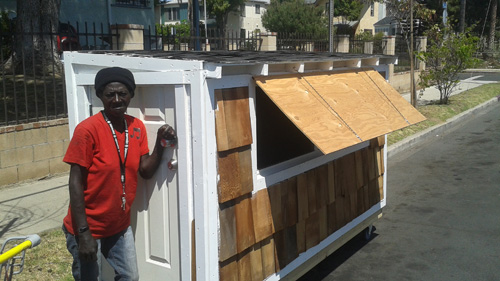Irene “Smokie” McGhee: 1955-November 8, 2016

Leslie Evans
Smokie, as her friends always called her, died November 8. She had won some fame as the first recipient of one of Elvis Summers’ tiny houses. The LA Times noted her passing with a photo of Elvis leaning over her casket. The Times said she was in her late fifties. She had told me in April 2015 that she was sixty.
I first met Smokie in 2013. She lived on the streets in my West Adams neighborhood, thin and frail. She had a bicycle and a shopping cart, and would appear on most days with one or the other, collecting recycling to sell, her main income. She often went hungry. She said she had been homeless since 2004, when her husband died of lung cancer. Sometimes I’d give her a dollar or two, once in a while a five. I had known her for a year or two before she would tell me that her real name was Irene. She was said to be a grandmother, but she did not speak to me of her children.
One day in April 2015 she came up to me, all excited. “I have a house!” she cried. “Come see my house!” I followed along a block or two, and there, parked in the street by the curb was a little house on wheels. “A friend built it for me,” she said. This proved to be Elvis Summers, who would later build many tiny houses for the homeless, switching to a larger design than this first attempt.
Smokie’s house had a real door with a dead-bolt lock, windows, with a screen, a drop-down wood awning for shade and privacy, and a slanted roof to let the rain run off, with real asphalt shingles.
Smokie had a wide circle of friends, some homeless, some not. The homeless walked up or rode up on old bicycles, the housed stopped in their cars to talk to her. When, in May 2015, Rita Ware, a homeless woman, died while camping with her husband in tent in a desolate strip mall parking lot on my block, Smokie received a stream of visitors to her little house three blocks to the south.
She gained whatever fame was her share in life from her little house. Her story appeared in the Los Angeles Times, but then spread to television and online media: CNN, National Public Radio, CBS, and ABC. It was picked up by the New York Daily News and People Magazine, then Reader’s Digest and the Toronto Star. It finally jumped the Atlantic, where in Great Britain it was covered by the Telegraph, the London Daily Mail, and the Independent. In Germany, the leading news magazine, Der Spiegel, ran her picture, as did the French online news site Positivr.
On most days after that you could find Smokie sitting in the doorway of her tiny house. She had to roll it across the street twice a week because of street cleaning. In the summer, despite its window, it became extremely hot. I bought her a solar powered fan, which helped a little.
Our then-Southwest LAPD Senior Lead Officer, Tracy Banuelos, agreed to watch out for Smokie’s little house, and began looking for some place off the street that would let Smokie park it safely. No one agreed. Then the neighbors began to complain. Tracy held off as long as possible before asking Smokie to move elsewhere. Finally, the din of complaints was too great, and Smokie was told she had to move a block to the east, to Budlong Avenue near Jefferson Blvd. She cried, protesting that Budlong was rife with gang members and drug dealers.
In the end, she had to move. For a while I would see her on Budlong, opposite the grassy strip outside the Freeport-McMoRan oil drill site, where there was a continual yard sale taking place, supplemented with surreptitious drug sales. Sometime early in 2016 she disappeared. Her little house sat untended for a long time. Months went by, and then it too disappeared. Later I found that it had been retrieved by another homeless friend, who pushed it a mile or so away to his alley, where he exchanged it for the scavenged table he had been sleeping under. It is still there.
Smokie was a heroin addict. I don’t know how long she was on the needle, but it had been some years. One day a woman I know who has a home near where Smokie had been living told me that Smokie had fled from Budlong when she was threatened for failing to pay her drug bill. After Smokie’s death I saw my friend again. This time she told me that Smokie, after she left Budlong Avenue, had taken refuge under a bridge near Skid Row. She said Smokie died there of a heroin overdose. One of my homeless friends confirmed that story.
Could Smokie have been saved? Living for years in destitution on the streets leads many of the homeless to drugs and alcohol – though sometimes the spiral downward starts with the addiction. In either case, providing a stable place to live and case management has pulled many back from the brink. The only offer Smokie had was from Elvis Summers. It was a reprieve, a remission, but it proved to be only a temporary one.
Comments
Leave a Reply
You must be logged in to post a comment.



